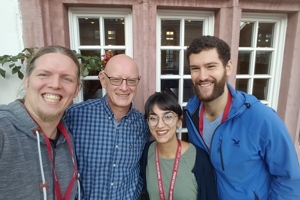The Role of ER-Resident Glycosylation in Vertebrate Neural Development
The perception of the extracellular environment is of key importance in particular for neural development. Crucial events in neural development e. g. the neural plate patterning or axonal outgrowth highly depend on cell-surface interactions to facilitate cell-cell contacts, the adhesion to the cellular matrix or perception of extracellular signals. Extracellular surface proteins are modified by N-glycosylation as well as C- and O-mannosylation or combinations of these. These modifications affect protein functionality. Consequently, impaired glycosylation results in severe defects of brain / neuronal development in human patients. Fish models offer alternative routes to study glycosylation during neural development. Extrauterine development of fish embryos allows the observation of phenotypes from the earliest stages onwards. This fact together with modern tools of genome editing (CRIPR/Cas9) facilitate the establishment and detailed molecular and developmental analyses of tractable animal models that closely resemble human syndromes. We will focus on the clearly tractable effects in the developing retina as model for a complex neural structure. The life-long growth of the fish retina allows to continuously study the impact of glycosylation during the life-long neurogenesis in the retina.
We build on our expertise in genome editing to establish GFP knock-in alleles for the key enzymes worked on in the context of the Research Unit. Our study aims at addressing the role of the three major glycosylation pathways during neural development. Targeting the loci of the Glyocosyl/Mannosyl transferases by knocking-in GFP will instantly provide tools for the detailed expression analysis of the three major pathway components. The models established will provide the organismal context for the biochemical and molecular analyses performed by the other partners in the Research Unit.
Team
 Thomas Thumberger (PI) graduated in developmental biology (University of Hohenheim), analyzing the evolutionarily conserved establishment of the left-right body axis (asymmetric orientation of the inner organs) in vertebrates. He has specialized in and adapted the CRISPR/Cas9 toolbox for use in medaka and other (model) organisms which is key to generate fish mutants as model for the human CDG syndromes in the consortium. The overarching topic in his research is the understanding how Glycosylation impacts on (neuronal) development during embryogenesis and maintenance of organs.
Thomas Thumberger (PI) graduated in developmental biology (University of Hohenheim), analyzing the evolutionarily conserved establishment of the left-right body axis (asymmetric orientation of the inner organs) in vertebrates. He has specialized in and adapted the CRISPR/Cas9 toolbox for use in medaka and other (model) organisms which is key to generate fish mutants as model for the human CDG syndromes in the consortium. The overarching topic in his research is the understanding how Glycosylation impacts on (neuronal) development during embryogenesis and maintenance of organs.
Jochen Wittbrodt graduated in Cancer Genetics (LMU Munich) identifying the melanoma inducing oncogene in Xiphophorus and has been working on fish development and stem cell biology ever since. His lab has strong expertise in advanced genetics and imaging and has focused on in vivo approaches addressing developmental and stem cell aspects in the retina, brain and intestine.
In his PhD project, Alex Cornean focuses on the analysis of PomT1/PomT2 mediated O-Mannosylation in medaka. Besides the organismal phenotypes caused by different levels of residual enzyme activity, he is interested in unraveling the differential O-Mannosylation pattern on specific target proteins in a collaboration with the groups of Sabine Strahl and Erdmann Rapp.
Sevinç Gücüm, the second PhD student in the project, is establishing fish models to understand the role of Alg2, Pmm2 as well as other N- and C-Glycosylation pathway effectors. Based on the human CDG syndrome database, i.e. the known genomic mutations (in collaboration with Chrstian Thiel, Hans Bakker and Falk Büttner), the established models will serve for supplementation / screening assays to potentially find new pharmacological compounds for future treatment of patients.
For more information on Jochen Wittbrodt’s lab go to his website.
Collaboration
While studying the impact of glycosylation on embryonic development and stem cell maintenance, we provide the organismal context for the Research Unit. We will generate the fish mutants for the key glycosylation enzymes, i.e. depending on the gene, we will collaborate with the groups of Christian Thiel P9 (alg1, alg2, alg11), Falk Büttner P3 (Pmm2), Sabine Strahl P8 (Pomt1, Pomt2), Hans Bakker P1 (dpy19l1), Britta Brügger P2 (dpm3) and Erdmann Rapp P4, differential glycosylation of fish mutants and wildtype specimens). Together with Irmi Sinning P7 structure-function relations will be validated on an organismal basis in fish.
